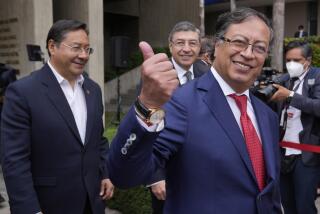Kadafi forces show Libya’s northwest under government control
- Share via
Reporting from Ajaylat, Libya — A burned-out police station and the absence of the once-ubiquitous portraits of Col. Moammar Kadafi are evidence of what happened here recently. The camouflage-clad soldiers wielding AK-47s and glaring at passing motorists show who is in charge now.
“God. Moammar. Libya. And that’s it,” said a handwritten sign displayed at a hastily set-up checkpoint at the center of this once-contested town.
An emboldened Libyan government on Thursday took a large group of journalists across the lengthy expanse of the country’s northwestern corridor to the Tunisian border in an attempt to show how firmly it was in control here.
The northwest is one of the sparsely populated nation’s most developed areas, home to industry, a major oil refinery and numerous small cities, as well as the capital, Tripoli. Kadafi’s consolidation of power over the restive piece of real estate, which appears to have taken place over the last few days, may explain his bold gambit Wednesday to try and seize rebel-controlled Port Brega, the oil terminal community far to the east of his center of power.
Kadafi’s forces turned their sights on Port Brega — without success — only after they had apparently neutralized any large-scale rebellion in the northwest. At the same time, an air of uncertainty hung over the largely barren scrubland.
Opposition supporters have called for renewed protests Friday in the region’s government-controlled areas. In apparent anticipation, authorities late Thursday shut down the Internet, cellphone service and other means of communications in Tripoli and flooded the highway west with tanks and other armored vehicles.
Along the 110-mile stretch between Tripoli and the Tunisian border, there were few visible signs that the unrest reported in recent days by refugees fleeing the country and residents reached by telephone was continuing in the region.
But with the large number of government checkpoints to maneuver past, and efforts to avoid any possibly rebel-controlled areas, a tour that normally would have taken no longer than five hours became a 12-hour journey.
Checkpoints that had been run by rebels along the highway to Tunisia had apparently been dismantled. A massive government checkpoint stood at the capital’s western edge, where uniformed men loyal to Kadafi searched cars and checked identity papers of travelers headed both east and west.
A mishmash of security forces including soldiers in olive garb, police officers, militiamen, men in street clothes and possible mercenaries from sub-Saharan Africa manned the large checkpoint. Some aimed high-caliber machine guns at approaching vehicles.
Pickup trucks with antiaircraft guns and soldiers camped out in tents were scattered along the northwestern roadway.
Outside Zawiya, the western coastal city that is said to remain partly under rebel control, army checkpoints also were in place.
Witnesses said there have been significant increases in the number of government checkpoints, soldiers and weaponry along the highway since Saturday, when journalists were taken to Zawiya by government minders.
On Thursday, a diplomat counted 50 checkpoints between the capital and the Tunisian border.
It was impossible to tell during the tour whether rebels had given up their positions without a fight. There was little evidence of gunfire or destruction, except for the numerous burned and damaged billboards that had once displayed Kadafi’s portraits, and whitewashed walls that had been blanketed with graffiti.
“That’s what we are here to see,” said a volunteer interpreter. “That things are going back to normal.
“You see how it is with the ordinary people living their lives.”
To emphasize how little the uprising had disrupted life in this key area, minders took reporters to an oil refinery in Zawiya province that usually processes 120,000 barrels of oil a day into gasoline, diesel and kerosene for domestic use and export.
Soldiers were stationed at a military base across from the 2,000-employee refinery’s entrance. According to board Chairman Nasir Sharif, the state-owned Zawiya Oil Co., one of the nation’s largest, is operating at 80% to 90% of capacity despite the absence of some workers due to the unrest.
Sharif said plant managers had reinforced fire prevention operations since the troubles began, but had implemented no major new security measures.
“We are oil,” he told reporters. “We deal with products of a flammable nature, [so] we [always] have to be concerned.”
All along the route, the signs of the recent unrest remained visible. In the city of Surman, a large building described as a government administrative headquarters had been shorn of flags and portraits of Kadafi. Not a single portrait was left in the city center.
In Sobrata, the scene of reported seesawing struggles between government and opposition forces, pro-government forces were firmly in charge of the city center on Thursday. But the front hood of a military vehicle was covered with white tape to hide graffiti.
Along the stretch of roadway between Zawiya and Bukamash, not a single portrait of Kadafi appeared on billboards or government buildings.
At the Ras Ajdir crossing into Tunisia, soldiers were in firm control and government supporters staged a rally when the journalists arrived. Yet here, the customs terminal was empty, evidence of the reported defection of Libyan customs officials to Tunisia. Also missing was a huge poster of Kadafi that had greeted visitors less than a week ago.
More to Read
Sign up for Essential California
The most important California stories and recommendations in your inbox every morning.
You may occasionally receive promotional content from the Los Angeles Times.













